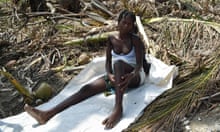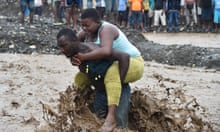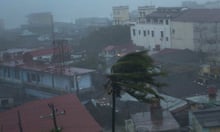The number of people killed in Haiti by the devastating effects of Hurricane Matthew was reported by Reuters to have risen as high as 842 on Friday as rescue workers and aid agencies battled to reach remote areas of the country, assess the damage and deliver relief.
The hurricane, which hit Haiti on Tuesday, brought 145mph winds and torrential rains that destroyed more than 3,200 homes, displaced 15,000 people, ruined plantations and drowned animals.
With communications still down in many of the worst-affected areas, it will take days before a definitive death toll can be established. The government puts the number of dead at 122, Radio Television Caraibes at 264, while Hervé Fourcand, a senator for the Sud department, said more than 300 people had died in the region. A Reuters tally of deaths reported by local civil protection officials suggested 842 people had died, but that figure has not been confirmed by the government or the civil protection agency.
The International Federation of the Red Cross and Red Crescent Societies estimates that more than one million Haitians have been affected, with hundreds of thousands of people in urgent need of humanitarian assistance. It has launched an appeal for £5.8m to help provide medical relief, shelter, water and sanitation over the next year.
By Friday morning Matthew was battering Florida, becoming the first major hurricane threatening a direct hit on the United States in more than 10 years.
Efforts to access the worst-affected areas of Haiti – including the Grand’Anse and Sud departments – were at first hampered by flooding, the collapse of communications networks and the destruction of a key bridge.
As the weather cleared, Haitian authorities, the UN and national and international non-governmental organisations were getting a better idea of the scale of the destruction. The airport in the capital, Port-au-Prince, reopened for humanitarian flights and communication was being restored to cut-off areas.
“Several dozen” were killed in the coastal town of Les Anglais in Sud Department, said Louis Paul Raphael, the central government’s representative in the region. Inland in nearby Chantal, the toll rose to 90 late in the evening, the town’s mayor said.
Marie Alta Jean-Baptiste, the head of the country’s civil protection directorate, warned the death toll was likely to rise as emergency workers reached the stricken regions.
“We do know there’s a lot of damage in the Grand’Anse, and we also know human life has been lost there,” she told the Associated Press.
The port city of Les Cayes in Sud was also feared to have suffered badly.
“The situation in Les Cayes is catastrophic, the city is flooded, you have trees lying in different places and you can barely move around,” its deputy mayor, Claudette Regis Delerme, told Reuters.
Natural disasters in Haiti
Haiti is all too accustomed to natural hazards and disasters. It was hit by four storms in 2008 – Fay, Gustav, Hannah and Ike – which killed more than 800 people. It also suffered dire flooding in 2002, 2003, 2006 and 2007. In 1963, Hurricane Flora killed 6,000 people in Haiti and Cuba.
In January 2010, a devastating earthquake flattened parts of the capital, Port-au-Prince, and killed at least 90,000 people. In its wake there was a cholera epidemic, unwittingly introduced by UN peacekeepers, which has claimed about 10,000 lives.
The devastation in Haiti prompted authorities to postpone a presidential election scheduled for Sunday.
Many victims were killed by falling trees, flying debris and swollen rivers when Matthew hit on Tuesday with winds of 145 miles per hour (230 kph).
Most of the fatalities were in towns and fishing villages around the western end of Tiburon peninsula in Haiti’s south-west, a region of white Caribbean beaches and rivers backed by hills.
The storm passed directly through the peninsula, driving the sea inland and flattening homes on Monday and Tuesday.
Yvonne Helle, the UN Development Programme’s Haiti director, said while the lack of access made getting precise numbers impossible at this stage, the scale of the damage was clearly enormous. She said the UNDP had received reports that up to 98% of the city of Jérémie, in Grand’Anse department, had been destroyed.
“It has an old historical centre and the old houses have been completely destroyed, ripped to shreds,” she said. “There are aerial pictures of the level destruction and it’s mind-boggling.”
Aid groups struggled to communicate with people in Grand’Anse. The Catholic Relief Services (CRS) said agricultural fields in Jérémie had been “decimated”.
“Houses in some areas like Jeremie and Dame Marie, which are difficult to access in normal times, are almost entirely destroyed and there are other areas where we don’t know how bad the damage was yet,” said CRS’s senior regional information officer for Latin America and the Caribbean, Robyn Fieser. “Shelter is a huge concern”.
Fieser said there was also an immediate need for food and water in the southern port town of Les Cayes as there are “scores” of people in shelters without access to them.

Enzo di Taranto, the head of the United Nations Office for the Coordination of Humanitarian Affairs (OCHA) in Haiti, said the agency was also waiting for a report on the northwest, where it was impossible for aircraft to fly until Thursday. “There has also been some damage in the northwest, but we have no information whatsoever at this stage,” Taranto said.
The UN described the hurricane as Haiti’s worst humanitarian crisis since the devastating earthquake six years ago. The rains and flooding have prompted fears of a surge in the cholera epidemic that has killed almost 10,000 people since the disease was accidentally introduced to Haiti by UN peacekeepers.
Helle said the 50-60cm of rain that had fallen in some areas had caused graves to open and flooded pit latrines.
“I think there are going to be serious, serious health concerns that will lead to communicable diseases related to water and sanitation,” she said. “I’m very worried about that and obviously we still have cholera and this will have an effect on our ability to control that.”
Action Aid issued a similar warning. Its country director, Yolette Etienne, said that more than 500,000 men, women and children urgently needed food, clean drinking water and safe shelter.
“Cholera is now a real danger as the already extremely poor sanitation system has been totally overwhelmed by flooding and heavy rainfall meaning the disease could spread quickly,” she said. “The situation is even worse in the shelters which often don’t even have enough toilet and are short of clean drinking water.”

According to the UN Office for the Co-ordination of Humanitarian Affairs, 15,263 people displaced by the hurricane have been placed in 152 shelters.
World Vision, which managed to get staff out to remote areas by helicopter on Wednesday, said sanitation, food and looking after children were its main concerns.
“Our teams are seeing a lot of damage, a lot of destruction and a lot of distress,” said Julie Lee, the charity’s spokeswoman in Haiti.
“Our biggest worry is children, who are most vulnerable in these times of disasters. We’re also worried about the crop damage … right now, this hurricane is wiping out the Congo bean crop, the sorghum crop – basically staples of the Haitian diet.”
The UN’s World Food Programme (WFP) and its children’s agency, Unicef, began mobilising resources. WFP arranged enough food supplies to feed 300,000 people for a month, with a further 34 tonnes of food on standby in Miami.
Unicef was preparing life-saving aid for 10,000 people in Haiti, while World Vision is to provide water and sanitation help to 50,000 families.

The UN’s Food and Agriculture Organisation was poised to deliver seeds to affected areas to help farmers rebuild their livelihoods.
US military personnel and nine helicopters were expected to arrive in Port-au-Prince over the coming days to help the relief effort.
In Aquin, a town outside Les Cayes, people braved the mud to see what Matthew had done to their clapboard houses and tiny shops.
Like many Haitians who were reluctant to leave their homes for fear of losing their personal belongings, Cenita Leconte had initially ignored official calls to evacuate as the hurricane hit. Eventually, however, she gave in – and in doing so probably saved her life.
“We’ve lost everything we own,” Leconte, 75, told AP. “But it would have been our fault if we stayed here and died.”

In 2010 a magnitude 7 earthquake wrecked Port-au-Prince, killing upward of 200,000 people. However, the impact of this tragedy has been felt most in remote but populated areas far from the capital’s support.
“We have nothing left to survive on, all the crops have gone, all fruit trees are down, I don’t have a clue how this is going to be fixed,” said Marc Soniel Noel, the deputy mayor of Chantal.








